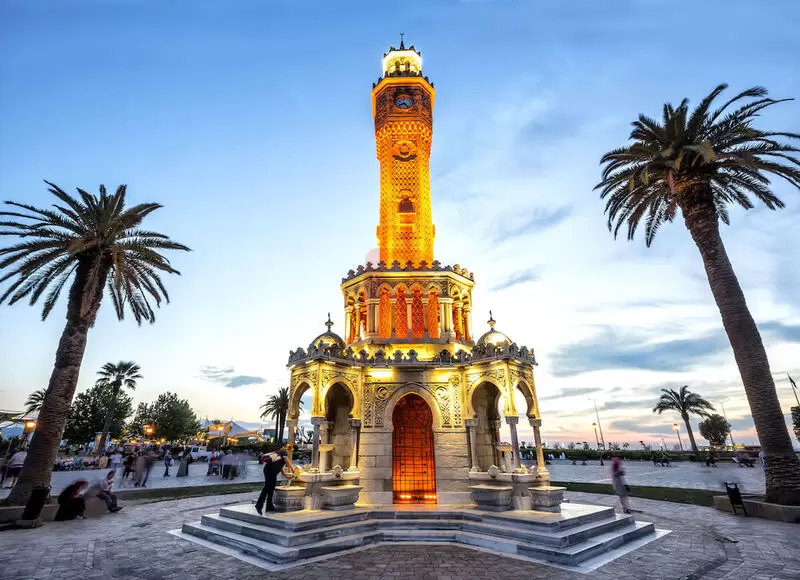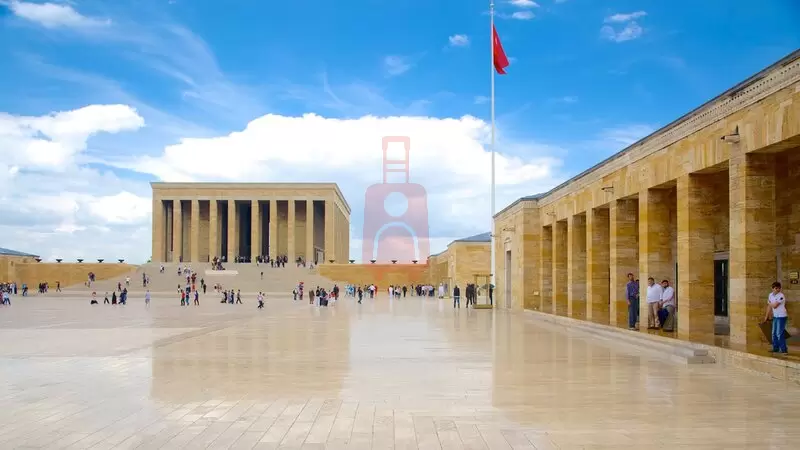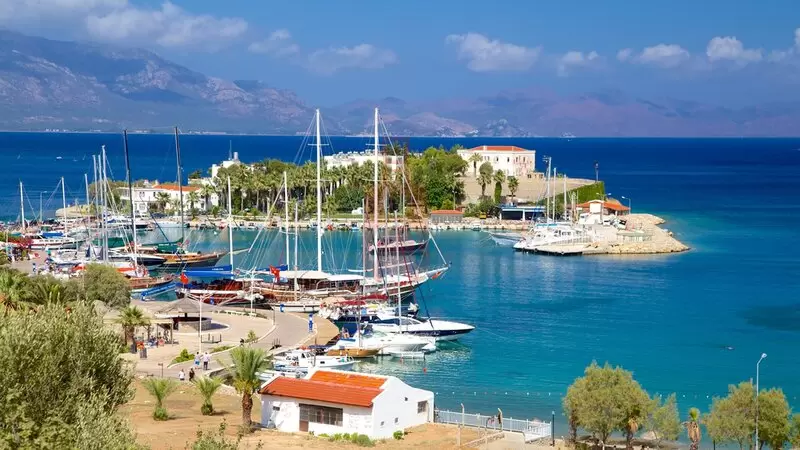
Izmir, located on Turkey’s Aegean coast, is a city steeped in history while embracing modern life. Known for its laid-back atmosphere, rich cultural heritage, and stunning seaside views, Izmir offers a perfect mix of ancient history, natural beauty, and vibrant city life. Whether you’re looking to explore historical sites, indulge in local cuisine, or simply relax by the sea, Izmir has something for everyone. Here’s a detailed guide to the best places to visit in Izmir and essential travel tips to help you make the most of your trip.
Best Places to Visit in Izmir
# 1. Konak Square and the Izmir Clock Tower
One of the most iconic landmarks of Izmir is the Izmir Clock Tower in Konak Square. Built in 1901 to commemorate the 25th anniversary of Sultan Abdulhamid II’s reign, the clock tower is a beautiful example of Ottoman architecture. Konak Square is the heart of Izmir, and the area is always bustling with locals and tourists alike. From the square, you can easily access many of the city’s main attractions, including government buildings, mosques, and markets.
Take a moment to enjoy the lively atmosphere and watch the world go by, or start exploring nearby attractions such as the Konak Pier, designed by Gustave Eiffel, and the Konak Yalı Mosque, a small but significant mosque dating back to the 18th century.
# 2. Kemeralti Bazaar
Just a short walk from Konak Square, you’ll find the Kemeralti Bazaar, one of the oldest and most vibrant markets in Turkey. This bustling market dates back to the 17th century and is filled with narrow, winding streets lined with shops selling everything from spices, textiles, and jewelry to ceramics and souvenirs. It’s a fantastic place to explore and immerse yourself in the local culture.
As you wander through the bazaar, you’ll also find plenty of spots to stop for a traditional Turkish tea or coffee. Make sure to visit the Kızlarağası Han, a historic caravanserai located within the bazaar, which was once a resting place for travelers and merchants along the Silk Road and is now home to small shops and cafes.
# 3. Alsancak and the Kordon Promenade
For a more modern side of Izmir, head to Alsancak, one of the city’s most lively and cosmopolitan districts. Alsancak is known for its vibrant nightlife, stylish cafes, and restaurants. It’s a great place to explore during the day or night, offering a variety of dining options from traditional Turkish fare to international cuisine.
One of the highlights of Alsancak is the Kordon Promenade, a long waterfront walkway that stretches along the coast of the Aegean Sea. It’s a popular spot for both locals and tourists to take a leisurely stroll, enjoy the sea breeze, and watch the sunset. You’ll find plenty of cafes and restaurants along the promenade, making it a perfect place to relax with a coffee or a glass of wine while taking in the views.
# 4. Kadifekale (Velvet Castle)
For sweeping views of the city and the bay, head to Kadifekale, also known as Velvet Castle. Located on a hill overlooking Izmir, this ancient fortress dates back to the Hellenistic period, built by the successors of Alexander the Great in the 4th century BC. Although much of the castle is in ruins today, the views from the top are worth the visit.
From Kadifekale, you can see the entire city of Izmir, the Gulf of Izmir, and the surrounding mountains. In addition to the castle itself, the area around Kadifekale is home to archaeological excavations and ancient ruins, providing a fascinating glimpse into the city’s long history.
# 5. Ancient City of Ephesus
No trip to Izmir would be complete without a visit to the Ancient City of Ephesus, one of the most well-preserved and significant archaeological sites in the world. Located about an hour’s drive from Izmir, Ephesus was once a major Roman city and is now a UNESCO World Heritage Site.
Highlights of Ephesus include the Library of Celsus, the Great Theatre, and the Temple of Artemis, one of the Seven Wonders of the Ancient World. As you walk through the ancient streets of Ephesus, you’ll be transported back in time, imagining what life was like in this once-thriving city.
Ephesus is a popular day trip from Izmir, and there are plenty of guided tours available that will take you through the history and significance of this incredible site.
# 6. Agora of Smyrna
Another important historical site in Izmir is the Agora of Smyrna, an ancient Roman marketplace located in the heart of the city. The Agora was originally built during the Hellenistic period but was later rebuilt by the Romans after an earthquake in 178 AD.
Today, the ruins of the Agora are a fascinating place to explore, with well-preserved columns, arches, and inscriptions. The site offers insight into the daily life of the ancient people who once lived in Smyrna (modern-day Izmir). The Agora is also one of the best places in Izmir to see remnants of the city’s Roman past.
# 7. Izmir Archaeological Museum
For a deeper understanding of the region’s history, make sure to visit the Izmir Archaeological Museum, located near Konak Square. The museum houses an impressive collection of artifacts from ancient Greek, Roman, and Byzantine periods, including statues, pottery, and jewelry.
The exhibits are well-organized and provide a comprehensive overview of the rich history of Izmir and the surrounding region. Highlights include statues of Roman emperors, ancient coins, and marble reliefs from the city of Ephesus.
# 8. Mount Spil National Park
If you’re looking for a nature escape, take a day trip to Mount Spil National Park, located about an hour’s drive from Izmir. The park is famous for its stunning landscapes, hiking trails, and diverse flora and fauna. It’s a great place for outdoor activities such as hiking, picnicking, and birdwatching.
One of the park’s most famous attractions is the crying rock of Niobe, a natural rock formation said to resemble a woman weeping, based on the legend of Niobe from Greek mythology. The park also offers breathtaking views of the surrounding mountains and valleys.
# 9. Seferihisar and Sığacık
For a more relaxed, off-the-beaten-path experience, head to the seaside town of Seferihisar and the nearby village of Sığacık. Seferihisar is known for being Turkey’s first Cittaslow (slow city), a designation given to towns that promote sustainable living, local culture, and a slower pace of life.
Sığacık is a charming fishing village with a small harbor, narrow streets lined with whitewashed houses, and a weekly farmers’ market where you can buy fresh, locally-produced goods. It’s the perfect place to unwind and experience the slower side of life in Izmir.
# 10. Şirince Village
Another great day trip from Izmir is to the picturesque Şirince Village, located in the hills near Ephesus. This small, traditional village is famous for its well-preserved Ottoman-style houses, cobblestone streets, and local wines.
Şirince is known for its warm hospitality, and you can spend the day wandering the village, visiting local wineries, and enjoying homemade Turkish meals at family-run restaurants. The village is also known for its production of fruit wines, so be sure to sample a glass or two while you’re there.
Essential Travel Tips for Izmir
1. Best Time to Visit: The best time to visit Izmir is during the spring (April to June) and fall (September to November) when the weather is mild and pleasant. Summers can be very hot, while winters are generally mild but can be rainy.
2. Getting Around: Izmir has a well-developed public transportation system, including buses, trams, and ferries. The İzban train and Eshot buses are convenient for getting around the city and its surrounding areas. Taxis are also available, but make sure the driver uses the meter to avoid overcharging.
3. Currency: The currency in Turkey is the Turkish Lira (TRY). Credit cards are widely accepted, but it’s a good idea to carry some cash for smaller shops, markets, and transportation.
4. Local Cuisine: Izmir is famous for its delicious food, so be sure to try local specialties such as boyoz (a pastry), kumru (a sandwich with cheese, sausage, and tomatoes), and gevrek (similar to a bagel). Don’t miss the fresh seafood available at many of the city’s restaurants along the coast.
5. Safety: Izmir is generally a safe city for tourists, but as with any destination, it’s important to stay aware of your surroundings and take basic precautions, such as keeping an eye on your belongings in crowded areas.
6. Language: Turkish is the official language, but many people in tourist areas speak English. It’s helpful to learn a few basic Turkish phrases to enhance your experience and communicate with locals.
Conclusion
Izmir is a dynamic city that seamlessly blends ancient history with modern living. From exploring the bustling streets of Kemeralti Bazaar to relaxing along the Kordon Promenade or taking day trips to nearby historical sites like Ephesus, Izmir offers a diverse range of experiences for every type of traveler. Whether you’re drawn to its rich cultural heritage, beautiful coastline, or vibrant city life, Izmir is sure to leave a lasting impression.











